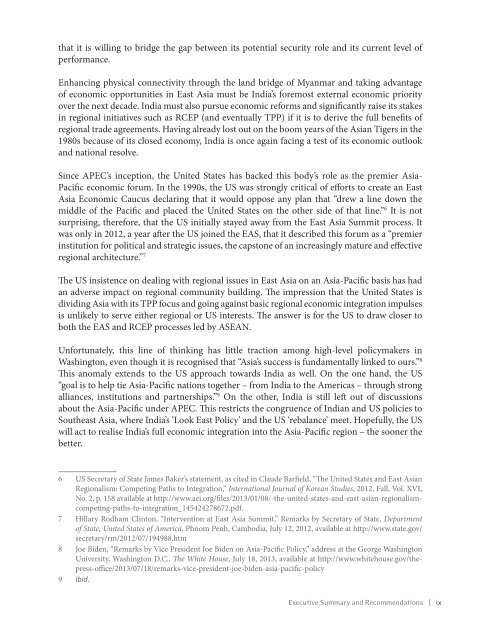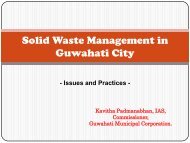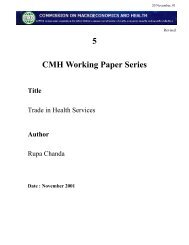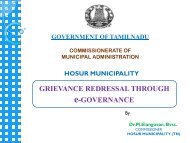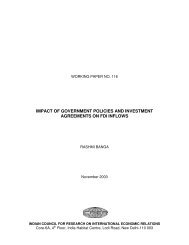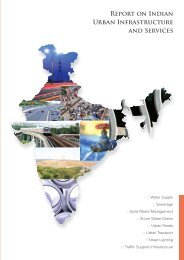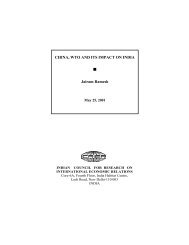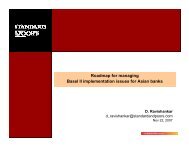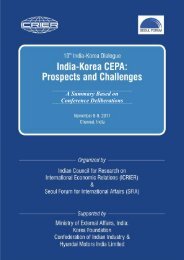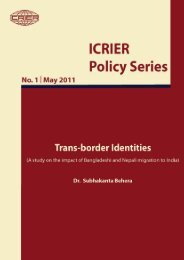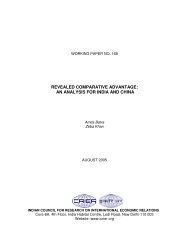Asia's Arc of Advantage - icrier
Asia's Arc of Advantage - icrier
Asia's Arc of Advantage - icrier
You also want an ePaper? Increase the reach of your titles
YUMPU automatically turns print PDFs into web optimized ePapers that Google loves.
that it is willing to bridge the gap between its potential security role and its current level <strong>of</strong><br />
performance.<br />
Enhancing physical connectivity through the land bridge <strong>of</strong> Myanmar and taking advantage<br />
<strong>of</strong> economic opportunities in East Asia must be India’s foremost external economic priority<br />
over the next decade. India must also pursue economic reforms and significantly raise its stakes<br />
in regional initiatives such as RCEP (and eventually TPP) if it is to derive the full benefits <strong>of</strong><br />
regional trade agreements. Having already lost out on the boom years <strong>of</strong> the Asian Tigers in the<br />
1980s because <strong>of</strong> its closed economy, India is once again facing a test <strong>of</strong> its economic outlook<br />
and national resolve.<br />
Since APEC’s inception, the United States has backed this body’s role as the premier Asia-<br />
Pacific economic forum. In the 1990s, the US was strongly critical <strong>of</strong> efforts to create an East<br />
Asia Economic Caucus declaring that it would oppose any plan that “drew a line down the<br />
middle <strong>of</strong> the Pacific and placed the United States on the other side <strong>of</strong> that line.” 6 It is not<br />
surprising, therefore, that the US initially stayed away from the East Asia Summit process. It<br />
was only in 2012, a year after the US joined the EAS, that it described this forum as a “premier<br />
institution for political and strategic issues, the capstone <strong>of</strong> an increasingly mature and effective<br />
regional architecture.” 7<br />
The US insistence on dealing with regional issues in East Asia on an Asia-Pacific basis has had<br />
an adverse impact on regional community building. The impression that the United States is<br />
dividing Asia with its TPP focus and going against basic regional economic integration impulses<br />
is unlikely to serve either regional or US interests. The answer is for the US to draw closer to<br />
both the EAS and RCEP processes led by ASEAN.<br />
Unfortunately, this line <strong>of</strong> thinking has little traction among high-level policymakers in<br />
Washington, even though it is recognised that “Asia’s success is fundamentally linked to ours.” 8<br />
This anomaly extends to the US approach towards India as well. On the one hand, the US<br />
“goal is to help tie Asia-Pacific nations together – from India to the Americas – through strong<br />
alliances, institutions and partnerships.” 9 On the other, India is still left out <strong>of</strong> discussions<br />
about the Asia-Pacific under APEC. This restricts the congruence <strong>of</strong> Indian and US policies to<br />
Southeast Asia, where India’s ‘Look East Policy’ and the US ‘rebalance’ meet. Hopefully, the US<br />
will act to realise India’s full economic integration into the Asia-Pacific region – the sooner the<br />
better.<br />
6 US Secretary <strong>of</strong> State James Baker’s statement, as cited in Claude Barfield, “The United States and East Asian<br />
Regionalism: Competing Paths to Integration,” International Journal <strong>of</strong> Korean Studies, 2012, Fall, Vol. XVI,<br />
No. 2, p. 158 available at http://www.aei.org/files/2013/01/08/-the-united-states-and-east-asian-regionalismcompeting-paths-to-integration_145424278672.pdf.<br />
7 Hillary Rodham Clinton, “Intervention at East Asia Summit,” Remarks by Secretary <strong>of</strong> State, Department<br />
<strong>of</strong> State, United States <strong>of</strong> America, Phnom Penh, Cambodia, July 12, 2012, available at http://www.state.gov/<br />
secretary/rm/2012/07/194988.htm<br />
8 Joe Biden, “Remarks by Vice President Joe Biden on Asia-Pacific Policy,” address at the George Washington<br />
University, Washington D.C., The White House, July 18, 2013, available at http://www.whitehouse.gov/thepress-<strong>of</strong>fice/2013/07/18/remarks-vice-president-joe-biden-asia-pacific-policy<br />
9 Ibid.<br />
Executive Summary and Recommendations | ix


